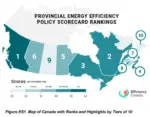
Efficiency Canada has released a report that ranks Canadian provinces based on the efforts they make towards saving energy. The study, which is the first of its kind in Canada, has generated quite a buzz on the internet — in other words, an ocean of memes. Many people were surprised to see their province in the top spots, whereas others were shocked to find out how energy-inefficient their province is.
Efficiency Canada is an organization that aims to create a sustainable environment and to better the lives of Canadians via energy efficiency. The report, known as the Provincial Energy Efficiency Scorecard, ranks provinces based on five criteria with different weights, including energy efficiency programs, enabling policies, buildings, transportation and industry.
Overall, the Provincial Energy Efficiency Scorecard aims to act as an “annual process of tracking, benchmarking and reporting on energy efficiency policies and performance.”
Read on to find out which are the most energy-efficient provinces in Canada, as well as the criteria behind the Provincial Energy Efficiency Scorecard report.
The most (and the least) energy-efficient Canadian provinces
Out of all the provinces, British Columbia has the best energy efficiency rating and ranks first, with a score of 56. In particular, BC is known for its Energy Step Code program, which creates a path for local governments to achieve net-zero energy-ready buildings. Following British Columbia in terms of ranking are Quebec (48 points), Ontario (47 points), Nova Scotia (45 points) and Manitoba (32 points).
Provinces ranked by energy efficiency: Here’s a detailed list of the top 10 Canadian provinces for energy efficiency.
- British Columbia
- Québec
- Ontario
- Nova Scotia
- Manitoba
- Alberta
- Prince Edward Island
- New Brunswick
- Saskatchewan
- Newfoundland and Labrador
In comparison to other provinces, energy efficiency in Alberta falls a little short — Alberta’s energy efficiency ranking is sixth overall, with a total of 30 points. The Efficiency Canada study identified some weaknesses in Alberta’s energy savings targets and policy stability.
In particular, Alberta lost points for energy efficiency policy cancellations (for example, the Residential and Commercial Solar program) and for not having any formal energy savings targets. In addition to this, policy changes such as the cancellation of the carbon levy in May 2019 also caused fewer points to be awarded to Alberta.
However, the strengths of Alberta included electricity program savings financing. In comparison to the other regions, the province scored the highest for financing scoring, with full points in repayment mechanisms and credit enhancements. What’s also interesting to note is that Alberta is the only province with a credit enhancement program — the Green Loan guarantee program that’s offered by Energy Efficiency Alberta.

Why should I care about energy efficiency?
Throughout this entire post, you may have been wondering “why does energy efficiency matter?” Although this is quite a long story, it’s safe to say that energy efficiency is one of the most effective ways of reducing both energy costs and your carbon footprint.
Energy efficiency can lessen your energy bills and leave extra money in your budget for other things. In addition, it can benefit the environment by reducing your consumption. Saving energy at home isn’t as hard or expensive as you may think — it often requires as little effort as changing out your incandescent bulbs for more LED ones.
In case you want to learn more about it, here’s a full guide on how energy efficiency can make your life at home more affordable, eco-friendly and comfortable.
How the energy efficiency levels were measured
Each of these main criteria can be broken down into sub-criteria. For example, the scoring for the energy efficiency programs criteria was made up of the following sub-criteria:
- Annual incremental savings from electricity efficiency programs
- Annual incremental savings from natural gas efficiency programs
- Nonregulated fuels efficiency programs
- Spending on efficiency programs
- Energy poverty programs
For the enabling policies criteria, the sub-criteria included:
- Energy efficiency savings targets
- Support for financing
- R&D innovation
- Training and professionalization
- Grid modernization
- Carbon pricing
The buildings criteria consisted of the following sub-criteria:
- Building codes
- Code and compliance activities
- Energy rating and disclosure
- Appliance and equipment market transformation
The transportation criteria include:
- Zero-emission vehicle mandate
- Electric vehicle public charging policies
- High-efficiency vehicle consumer incentives
- Support for EV/PHEVs in building codes
- EV registrations
- Number of public electric vehicle charging stations
- Commute to work shares
Finally, the industry criteria consisted of the following sub-criteria:
- Policies to encourage energy management systems
- Cogeneration
Compare energy rates
Although energy efficiency is essential, there’s plenty of other ways you can cut down on your energy bills. One of them is comparing electricity and natural gas rates. At EnergyRates.ca, you can see a list of the best available energy providers and their current plans in your area. The website is a free and unbiased cost comparison tool for you to compare electricity and natural gas rates all across Canada.
The best thing about EnergyRates.ca is that you can compare electricity and natural gas rates regardless of your energy consumption size, whether it’s residential, business, commercial, large commercial or industrial electricity and natural gas rates. All you need to do is fill in your postal code and you will find a list of energy suppliers and their lowest available rates in your location. Commercial energy consumers can even get a custom free quote.
The energy rate comparison tool is available for energy consumers in Alberta, Ontario, BC, Saskatchewan and Manitoba.
Learn more:











